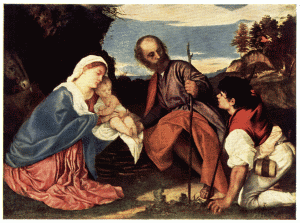Two more of the pictures of Titian's earliest period are in the National Gallery—the Christ appearing to Mary Magdalen (No. 270), and theHoly Family (No. 4). The former is ascribed to about the year 1514, partly on the ground that the group of buildings in the landscape is identical, line for line, with that in the Dresden Venus painted by Giorgione but completed by Titian after his death. The same landscape also occurs in the beautiful little Cupid in the Vienna abstract oil paintings for sale
PLATE XV.—TITIAN
THE HOLY FAMILY
National Gallery, London
THE HOLY FAMILY
National Gallery, London
Academy, and, as Mr Herbert Cook suggests, possibly represents
some cherished spot in Titian's memory connected with his mountain home at Pieve
di Cadore.
The Holy Family, above mentioned, is a most charming example of the sacra conversazione as developed by Titian from the somewhat formal and austere conception of Bellini and his contemporaries into something eminently characteristic of the secular side of his genius. The very titles of two of his most beautiful and most famous pictures of this sort proclaim the hold they have taken on the popular mind. The one is the Madonna of the Cherries,original oil paintings wholesale, in the Vienna Gallery. The other is theMadonna with the Rabbit, in the Louvre. In our picture the distinguishing feature is the kneeling shepherd, with his little water-cask slung on his belt, who puts us at once in touch with the whole scene by the simple appeal to our common human experience. Raphael could move our religious feelings to revere the godhead in the child, but could seldom, like Titian, stir our human emotions and bring home to us that Christ was born on earth for our sakes. oil paintings wholesale

No comments:
Post a Comment